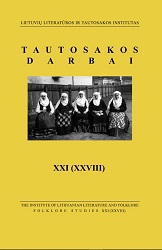MIRTIS IR LAIDOTUVĖS VĖLYVOSIOSE KARINĖSE-ISTORINĖSE DAINOSE: FOLKLORINIAI NAUJOS ISTORINĖS PATIRTIES ATSPINDŽIAI
DEATH AND FUNERAL IN THE LATE MILITARY-HISTORICAL SONGS: FOLKLORIC REFLECTIONS OF THE NEW HISTORICAL EXPERIENCE
Author(s): Vita IvanauskaitėSubject(s): Cultural history, Customs / Folklore, Military history, 19th Century, Pre-WW I & WW I (1900 -1919), Interwar Period (1920 - 1939), WW II and following years (1940 - 1949)
Published by: Lietuvių literatūros ir tautosakos institutas
Keywords: Military-historical songs; folklore; Funeral; folksongs;
Summary/Abstract: The subject of analysis in this article comprises folkloric motives related to death and funeral in the late Lithuanian military-historical folksongs. The scope of investigation embraces the songs that became popular approximately in the end of the 19th – beginning of the 20th century, chiefly related historically to the Russian–Japanese War and the World War I, in which Lithuanians had to participate as soldiers of the Tsarist Russian army. The main attention is paid in the article to the following folkloric motives of the songs: the seeing of the soldier off to the war and saying farewell to him; death in the battlefield, far away from home; the soldiers’ graves; the nameless mass burials; death without funeral. The farewell motives found in some of the examined songs contain reflections of certain rituals of farewell and seeing the man off to the war, existing in the traditional Lithuanian culture. The foreboding of death is very distinctly expressed here. In the late military-historical folksongs, image of the battlefield emerges as the specific space of death, becoming a popular folkloric motive.
Journal: Tautosakos darbai
- Issue Year: 2006
- Issue No: 32
- Page Range: 161-179
- Page Count: 19
- Language: Lithuanian

